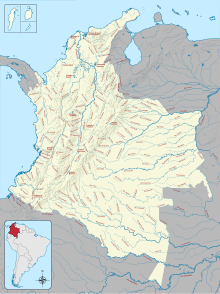| Río San Juan | |
|---|---|
 Rivers in Colombia. The mouth of the San Juan is near the center of the country's Pacific coast | |
| Location | |
| Country | Colombia |
| Region | Chocó Department |
| Physical characteristics | |
| Source | |
| • location | Cerro Caramanta, West Andes |
| Mouth | |
• location | Pacific Ocean near Buenaventura |
| Length | 380 km (240 mi) |
The San Juan River (Spanish: Río San Juan) is a Colombian river that flows into the Pacific Ocean through the Chocó Department. It is approximately 380 kilometres (240 mi) and drains a watershed of 16,000 square kilometres (6,200 sq mi). The river drains into a large delta that covers nearly 300 square kilometres (120 sq mi). The average discharge of the Rio San Juan is 2,054.67 m3/s.
Geography
The river begins on Cerro Caramanta in the West Andes. The delta is due north of Bahía Málaga and Buenaventura.
The mouth of the river has extensive stands of mangroves, part of the Esmeraldas-Pacific Colombia mangroves ecoregion.
Hydrometry
Fauna
Reptiles
A species of snake, Dipsas sanctijoannis, is named after the San Juan River of Colombia, and is native to the watershed.
Fish
- Andinoacara biseriatus - A Cichlid.
See also
References
- ^ Carlos Borda, Northern South America: Northern Colombia, WWF: World Wide Fund for Nature, retrieved 2017-06-19
- ^ Unesco - San Juan River at Penitas Archived 2016-03-03 at the Wayback Machine
- ^ Beolens, Bo; Watkins, Michael; Grayson, Michael (2011). The Eponym Dictionary of Reptiles. Baltimore: Johns Hopkins University Press. xiii + 296 pp. ISBN 978-1-4214-0135-5. ("St. John", p. 254).
- ^ Froese, Rainer; Pauly, Daniel (eds.) (2017). "Andinoacara biseriatus" in FishBase. May 2017 version.
External links
- (in English) San Juan River delta on coastal.er.usgs.gov
4°02′42″N 77°26′29″W / 4.04500°N 77.44139°W
